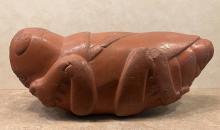chapolin (Mdz32r)
This element has been carved from the compound glyph for the place name, Chapolmoloyan. This grasshopper appears as a full insect in profile, facing to our right, two tones of green in color, with detail on face, eye, antennae, wing, abdomen, jumping leg (bent), and feet.
Stephanie Wood
The level of detail on this grasshopper suggests that artists had great familiarity with the insect and probably studied it very closely. The patterns on the femurs and lower abdomen (spiracles) are very much like those captured in this photo, https://news.okstate.edu/articles/agricultural-sciences-natural-resource.... The immediately recognizable, bent leg that allows the grasshopper to hop appears by itself as a signature glyph for Chapulicxitlan (representing chapolin, grasshopper, and icxitl, foot) on folio 8 recto of the Codex Mendoza. Detailed, concrete knowledge of this insect may be owing to the fact that the chapolines (as they are called in Mexican Spanish) were (and still are) consumed as food. They come in many sizes. They can be eaten in tacos or mixed with other ingredients. Chile and salt are often added. Because they were collected, sold in the marketplace, and consumed, people were very familiar with them and saw the close up.
Stephanie Wood
c. 1541, but by 1553 at the latest
Stephanie Wood
Ed Trager
chapulines, chapulín, insecto, grasshoppers, insects, insectos, comida
chapolin. Photo by Robert Haskett, Museo Nacional de Antropología e Historia, Salón Mexica, 14 February 2023.

chapol(in), grasshopper, https://nahuatl.wired-humanities.org/content/chapolin
grasshopper
el saltamontes, el chapolín, langosta
Stephanie Wood
Codex Mendoza, folio 32 recto, https://digital.bodleian.ox.ac.uk/objects/2fea788e-2aa2-4f08-b6d9-648c00..., image 74 of 188.
The Bodleian Libraries, University of Oxford, hold the original manuscript, the MS. Arch. Selden. A. 1. This image is published here under the UK Creative Commons, “Attribution-NonCommercial-ShareAlike 3.0 License” (CC-BY-NC-SA 3.0).





